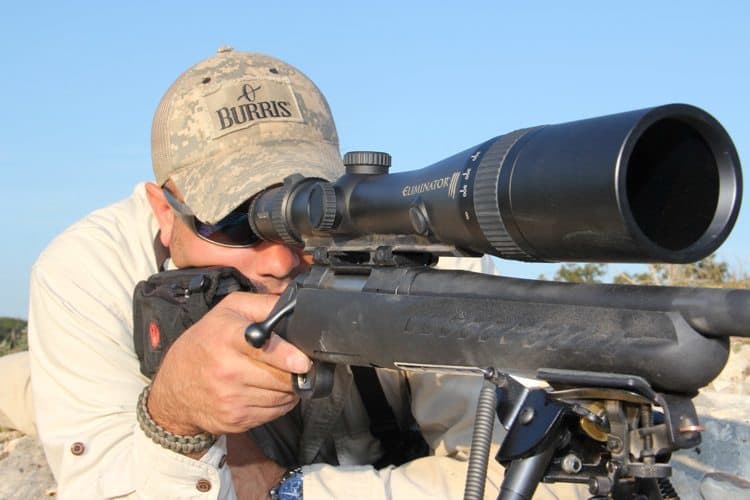You may have heard of a BDC reticle or a rangefinder reticle and know how they work in theory. However, if you have had no experience with using one of these, you may not know how to actually use one of these useful aiming points.
So, how do you do it? Follow this guide, and we will show you step by step how to use a rangefinder reticle.
Some Things You’ll Need
Scope With A Rangefinding Reticle – A rangefinder reticle scope will generally have a series of hash marks or bars arranged horizontally on the vertical line of the cross-hairs, below the mid-point. These marks represent certain distances of estimation for where your bullet is going to hit. Generally, these scopes have to be at a single magnification setting at which the reticle represents properly.
Remember that BDC (bullet drop compensator) reticles can be kind of a pain because while they are the ultimate all-in-one package, they are most accurate when all conditions meet the test or control condition and environment.
Rifle – This is self-explanatory. You will need your rifle in order to do your target shooting or other shooting. You can’t test out your reticle without it.
Appropriate Range And Target – You want to set up a nice, safe range to do your shooting at. Someplace that is free of distraction and wind, free of obstacles with a good solid back-stop. A shooting range would be the best place to get the best control setting. Most rangefinder reticles or BDC reticles are considered kind of a long-range reticle, but BDC works best if only out to about three hundred yards.
You want a target or targets that show very clearly where it is that your shots are hitting, so you can mark the accuracy of the reticle mark distances.
Simple Math Equation For Distance Determination – There are charts for finding range and bullet drop estimating, but there’s also a simple equation you can do to determine this. It’s target size in inches divided by MOA on reticle times a constant which should be 95.5, but some use 100. This will give you your yardage. If a deer chest is 18 inches and takes up 3 MOA on your reticle, then per the formula, 18/3=6×95.5=573 yards away. If the reticle is measured in MIL dots, the constant number is 27.8 rather than 95.5.
Safety Equipment – Safety glasses and earplugs or muffs. You want to protect your eyes and ears form prolonged shooting exposure.
Rangefinder – You will want to use this to pinpoint your range so that you know what distances the reticle marks are set to. You will only probably need this in the beginning to learn your ranges. After all, the beauty of a rangefinder reticle is that it is an all-in-one unit, so you don’t need to carry around your rangefinder.
Plenty Of Ammo – You will want to have lots of ammo and do lots of shooting at different yardages to be sure of accuracy of different reticle marks. You may also want to shoot different grain loads to see the difference in where they are hitting.
Related: Best Rangefinder Scopes
How To Use A Rangefinder Reticle
Step 1 – Determine Target Size
First, you want to determine your target size or height. If you know that a deer chest, in general, is about 18 inches then this would be your size. If you are looking at a fence post that is 3 feet off the ground, that must be converted to inches. 36 inches would be your size.
Step 2 – Do The Math And Find The Distance
Look at the target through your scope. However many MOA marks it takes up is your MOA denominator number. Your 18-inch deer chest takes up 2.5 MOA, so the math comes out to 18/2.5= 7.2×95.5= 687.6 yards away. If your reticle measures in MIL rads, the constant number is 27.8.
Step 3 – Choose The Corresponding Hash Mark For Your Range
If your range corresponds to the 5th hash mark, then use the 5th hash mark as your aiming point when you shoot. That all there is to it. You have found your range and compensated for it with your rangefinder reticle!
Related: How To Use a Rangefinder Scope
Common Questions
Which is better, MOA or MIL? – One is not better than the other, it is personal preference. It is important to be sure that your scope turrets match the reticle measurements though. You want to keep MOA measurement with MOA, and MILs with MILs. You also want to be sure you use the correct constant number for you measurement style, and not mix them up. MOA is 95.5, MIL is 27.8.
Are rangefinding reticle range marks constant and reliable? – Many people find them very reliable and super convenient. Remember that a BDC reticle is calculated very specifically to caliber, load weight, conditions or obstacles, pretty much it performs as perfectly as it’s own test conditions. Any of these settings off, and the reticle may not be as dead-on as would be hoped, but probably pretty close. Many hunters swear by them.
Conclusion
Rangefinder reticles are neat and useful little tools. Now that you know how to use a rangefinder reticle, practice makes perfect. With a little practice and getting used to the calculations, you will be well on your way to placing a perfect shot without having to carry around or fumble around for the rangefinder. It’s a win-win scenario.
Just keep in mind that you must practice with the ammunition that you plan to hunt with, or you may be off a little bit, and you don’t really want to find this out during the hunt when you’re staring down the barrel at a big ‘ol trophy buck at 600 yards! Just keep practicing and shooting and learning your reticle, and your in for a real treat during hunting season!
If you enjoyed this article you’ll probably like these:



